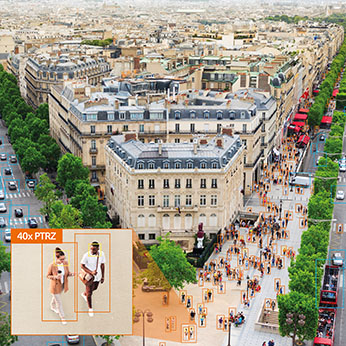Hanwha Vision is adding to its range of AI cameras with four- and five-channel multi-directional cameras, powered by an AI engine, that provide operators with a 360 degree view, and analytics.
The products classify and detect people, faces, vehicles (including vehicle types), and licence plates, as well as providing AI-based loitering and line crossing detection, Auto Prefer Shutter control, WiseStreamⅢ smart compression and WiseNRⅡnoise reduction. The camera models are PNM-C34404RQPZ, PNM-C16083RVQ and PNM-C32083RVQ.
AI cameras help minimise false alarms, which as the manufacturer says have plagued the electronic security industry for decades. In simple terms, Deep-Learning AI video analytics ignores video noise, waving trees, moving clouds and animals, all of which may trigger false alarms when standard motion detection technology or sensors are being used to detect activity because it has not been trained to look out for them.
Object classification also allows for more efficient forensic search, meaning security managers can find relevant event footage for investigation. Virtual areas can be set up with AI object detection so that if a person is identified as loitering in a specific area, an alert is sent to the operator for action. The developers add that AI is helping to improve the footage quality for operators, with the BestShot AI feature automatically choosing the best images of an object or event to send to a backend server, and minimising storage and bandwidth requirements.
Hanwha Vison’s AI compression technology, WiseStreamIII, can also apply low compression rates to objects and people detected in footage, and high compression to the remaining field of view. The WiseNR II noise reduction uses AI to reduce blur in noisy, low-light places. The solution is further complemented by AI-based ‘Prefer Shutter’ that automatically adjusts shutter speed to further reduce motion blur.
The multi-directional cameras require less cabling and infrastructure, compared with what would normally be required to enable up to five separate cameras to cover large scenes. Meanwhile the AI on the camera (edge AI) needs less server room space as analytics is carried out on the device and only metadata is transmitted.
Once the camera is installed, the PTRZ remote adjustment feature on the PNM-C34404RQPZ also allows users to adjust the camera settings, lens position, and viewing angle through a web viewer. Operators no longer have to be there at the camera installation site for every adjustment.
The camera comes with four independent infra-red (IR) zones and a long-range IR for the PTZ camera. Operators can manually adjust the intensity of each zone’s IR, preventing potential reflection issues from nearby objects. The cameras have a compact and smart semi-modular design, the designers add, for installation and maintenance.










